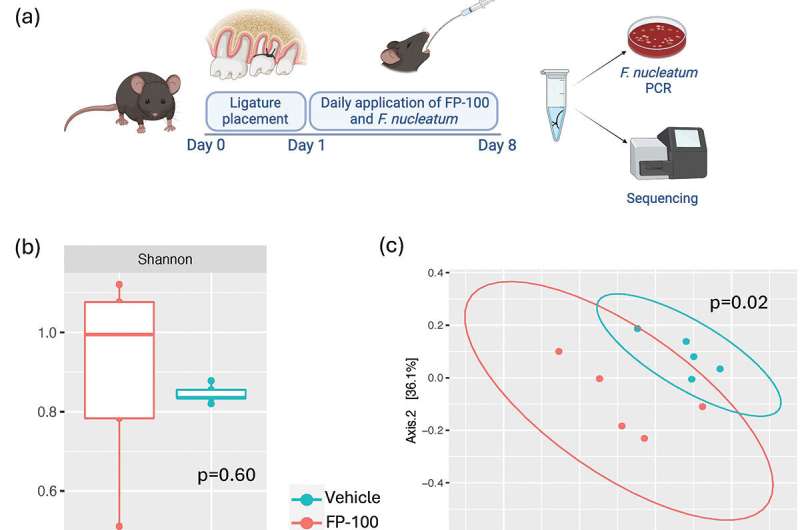This article has been reviewed according to Science X's editorial process and policies. Editors have highlighted the following attributes while ensuring the content's credibility:
fact-checked
trusted source
proofread
First narrow-spectrum antibiotic successfully eliminates Fusobacterium nucleatum, a gum disease pathogen

In a study published in the Journal of Oral Microbiology, ADA Forsyth scientists found that FP 100 (Hygromycin A), a first-in-class, small molecule, narrow-spectrum antibiotic, successfully eradicates Fusobacterium nucleatum without harming the oral or gut microbiomes.
Fusobacterium is a key pathogen triggering the onset of periodontitis (gum disease), and its progression has been linked with many serious systemic diseases. The researchers' recent discovery could help in the fight against severe gum disease and related systemic conditions.
FP 100 as an effective treatment for periodontitis
"This type of black and white data almost never happens," said Alpdogan Kantarci, DDS, Ph.D., a senior scientist at ADA Forsyth who led the study. "The results were so clear. With FP 100, we can eliminate Fusobacterium nucleatum from the oral cavity, reverse tissue destruction and prevent disease progression without harming the beneficial microbiome."
Lead authors, Dr. Nil Yakar Yilmaz and Dr. Ozge Unlu on Dr. Kantarci's team, demonstrated the drug was effective both in vitro and in a mouse model of periodontal disease. Drs. Lujia Cen, Hatice Hasturk, Tsute Chen, Wenyuan Shi, and Xuesong He also contributed to this exciting research.
"The findings provide strong evidence that FP 100 could be a game-changer in the treatment of severe gum disease," said Matt Tindall, Co-Founder and Chief Executive Officer of Flightpath Biosciences, Inc. "This antibiotic could work to prevent or treat advanced gum disease."
Gum disease affects over 47% of individuals aged 30 and older, with the prevalence increasing to 60% in those aged 65 and older. The later stages of the disease are characterized by progressive destruction of jawbone tissue and can lead to tooth loss. Current treatments focus on slowing the progression of the disease, but most of these are not covered by dental insurance. There is no available cure.
One of the most exciting findings in this study is that the antibiotic is effective at targeting just Fusobacteria without harming beneficial bacteria necessary for maintaining human health. Periodontal disease has long been a challenge to treat effectively because antibiotics typically wipe out both harmful and beneficial bacteria.
"Often, antibiotics treating that disease will also kill all the bacteria that aid in preventing overpopulation of pathogens," said Dr. Kantarci. "With the increase of antibiotic-resistant superbugs, being able to kill a dangerous pathogen with a narrow-spectrum antimicrobial drug candidate represents a significant paradigm shift in antibiotic development. Eliminating that key pathogen is a very important strategy to control the disease."
Implications for systemic health
The potential impact of this antibiotic extends far beyond the mouth, potentially preventing the development of serious chronic diseases, including heart disease, colon and pancreatic cancers, Alzheimer's disease, preterm birth, inflammatory bowel disease, and rheumatoid arthritis.
"Fusobacterium is an insidious pathogen," said Dr. Kantarci. "Studies show it can travel from the oral cavity to other places, where it colonizes and causes disease. We recently published a study showing that Fusobacterium can enter human cells like a Trojan horse and travel undetected to other parts of the body where they colonize and cause disease. Eliminating the bacteria early in the oral cavity is also systemic prevention."
This promising antibiotic candidate, FP 100 (hygromycin A), was rediscovered by a team of researchers led by Kim Lewis, Ph.D., Northeastern University, who focused on its ability to target the bacterium Borelliella burgdorferi, which causes Lyme disease.
ADA Forsyth and Flightpath Biosciences have filed a joint patent application for FP 100. They plan to explore the antibiotic's potential further in clinical trials and expand its application to other conditions caused by Fusobacterium nucleatum.
"We are entering a new frontier in both local and systemic disease prevention," said Dr. Kantarci. "The ability to selectively target harmful bacteria while preserving the beneficial microbiome opens the door to innovative treatments that could significantly improve patient outcomes."
More information: Nil Yakar et al, Targeted elimination of Fusobacterium nucleatum alleviates periodontitis, Journal of Oral Microbiology (2024). DOI: 10.1080/20002297.2024.2388900


















